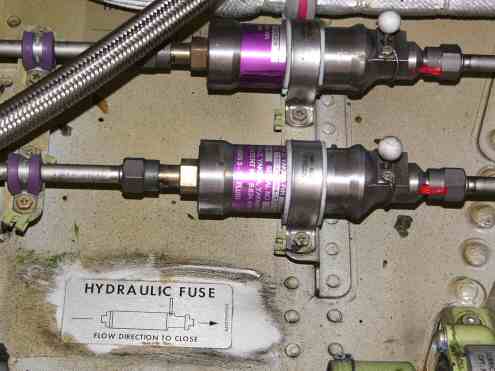Revival of thread, I unexpectedly have a 10 day deadline to get this done.
Another thought, someone posted a pic of a HYD FUSE for air craft, it senses pressure loss and shuts down the line to prevent fluid loss, this was brought up in the deuce brake thread, why could this not be incorporated into the split brake 5t system conversion, a FUSE for each wheel, so other then a major line loss, you would ONLY loose the breaking of one wheel if you lost a wheel cylinder. A wrecker or loaded dump or for that matter any loaded 5t needs All the breaking it can get.
Ron, that was
this post by outcast and then further expanded on in
this post:
As it has already brought up, Just wanted to add to it
This is out of a 737 Aircraft Tech manual. Kinda thinking this is the way I'm going to look more into.
Hydraulic Fuses.
These are essentially spring-loaded shuttle valves which close the hydraulic line if they detect a sudden increase in flow such as a burst downstream, thereby preserving hydraulic fluid for the rest of the services. Hydraulic fuses are fitted to the brake system,
This could work against a sudden, extreme loss of fluid, as in a ruptures line. Should be combined with a remote dual reservoir that can be easily topped up and has a warning buzzer for when the remote reservoirs go below a certain level, to warn for slow leaks before something ruptures AND a better emergency brake (maybe air assisted?). IF you have that, your single system is a lot safer, maybe even save enough to stay single
The one question is where to put those fuses. The first thing would have to be to replace all fixed lines, and then place the fuses where it makes sense.
The next question is to figure out the right fuses for this system to avoid false positives. That brings us to a potential problem: price. Could not find much on that yet, but I saw some starting at $30 a piece, some forums mentions closer to $100. That might add up with 6 fuses in the circuit. Might be easier to install but not necessarily cheaper.
First thoughts for location of fuses
Most simplest: three fuses close to the Air Pack each controlling the main line to an axle.
Front
If behind the split block towards each wheel: you will keep more braking power but if a flex line or cylinder goes while braking hard, you suddenly get all braking power to one side and you swerve or might even role over. Losing both front wheels might be preferable and definitely easier, just put the fuse directly behind the Air Pack.
Rear
First thing I would do is split the lines as close to the Air Pack as possible, so you will have two circuits going backwards (not sure but I think they split further backwards). Then, per circuit, put the fuses directly behind the split block or at least before the flexible line. Again, might be better to lose both wheels per axle as one wheel on one side, although certainly with the middle axle the results of losing only one wheel braking would be less dangerous than in front.
Alarms
you need to be warned that your system is not 100% anymore. That means with fuses (regardless if dual or single system) they must somehow warn when they come into action because they work quick enough for your low-reservoir warning to be not activated. That feature, if existing, might add to the cost per fuse.
In contrast, with a dual system without fuses a buzzer on the reservoir will tell you one system is low and out.
For me here in the Czech Republic, I definitely will look into the fuse idea. There are no 5-ton parts and not much scrap yards with pick-up or truck parts around here. So it means driving to the Netherlands or paying crippling shipping costs.


